
Morocco and Spain 1999
Page 2
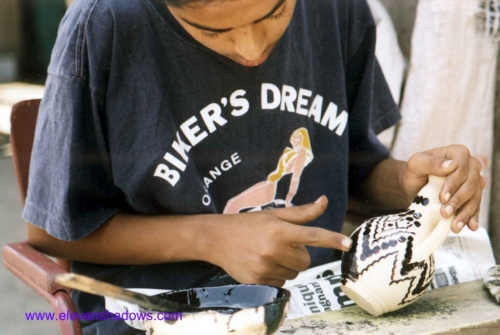 Painting vases in Place el-Hedim, Meknes
with only the fingertip. Painting vases in Place el-Hedim, Meknes
with only the fingertip. |
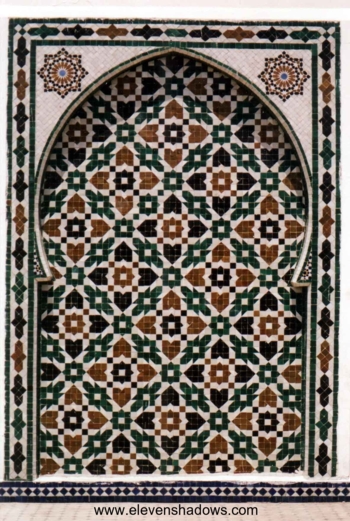 Ceramic tile detailing outside the Mausoleum of
Moulay Ismail, one of the greatest figures in Moroccan history. The second sultan of
the Alawite dynasty, this charming gentleman came to power partially by adorning the walls
of Fez and Marrakesh with the heads of 10,000 slain enemies slain in the north of Morocco.
He was responsible for raising the imperial city of Meknes to its greatest glory,
turning it into a sort of Versailles during his tenure. Ceramic tile detailing outside the Mausoleum of
Moulay Ismail, one of the greatest figures in Moroccan history. The second sultan of
the Alawite dynasty, this charming gentleman came to power partially by adorning the walls
of Fez and Marrakesh with the heads of 10,000 slain enemies slain in the north of Morocco.
He was responsible for raising the imperial city of Meknes to its greatest glory,
turning it into a sort of Versailles during his tenure. |
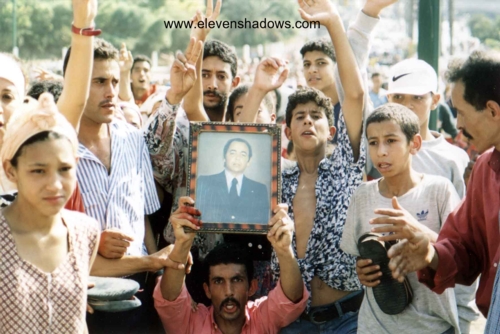 Sadly, King Hassan II, who reigned over Morocco
for 38 years, passed away. The next day, the streets in Meknes became a river of
people, weeping, chanting, singing songs of praise, and streaming through the streets
while carrying banners and pictures of their beloved king. Sadly, King Hassan II, who reigned over Morocco
for 38 years, passed away. The next day, the streets in Meknes became a river of
people, weeping, chanting, singing songs of praise, and streaming through the streets
while carrying banners and pictures of their beloved king. |
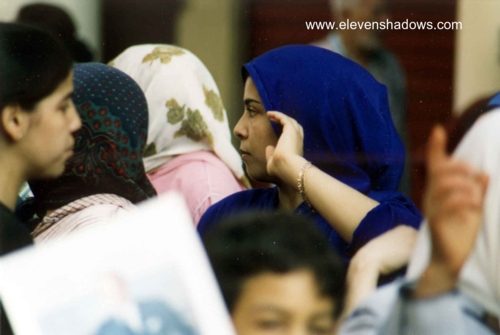 The King's passing was an emotionally charged, moving
experience that I will never forget. The King's passing was an emotionally charged, moving
experience that I will never forget. Everything in Meknes closed for a two days, and there were rumours circulating, especially among the foreign travelers, that everything would remain closed for longer, sending some travelers into a panic. |
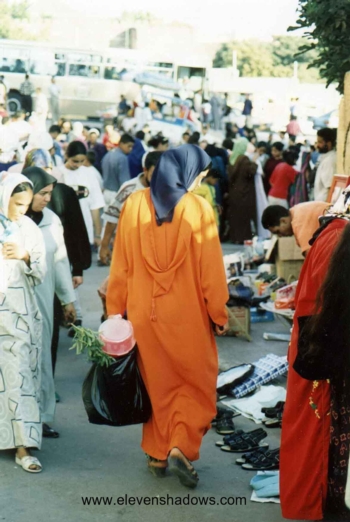 Meknes, near the mellah (Jewish quarter) and
down the street from the impressive Bab el-Mansour gate, the massive entrance to Moulay
Ismail's 17th century imperial city. Meknes, near the mellah (Jewish quarter) and
down the street from the impressive Bab el-Mansour gate, the massive entrance to Moulay
Ismail's 17th century imperial city.Although I did manage to see the Mausoleum of Moulay Idriss, the medina, and the interesting Dar Jamai Museum, I wasn't able to see as much of the city as I would have hoped due to the closure of everything. I also had time to wander through the old walled city. |
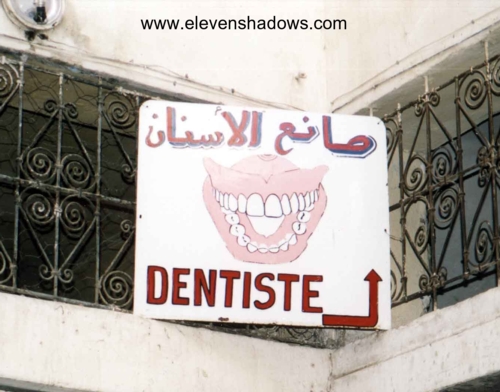 Dentist's
sign. Dentist's
sign.~~ I took an early morning bus to Fes, arriving at the main gate, Bab Bou Jeloud, of the walled medina early enough to get a hotel right by the square. Fes Al-Bali, the old walled city, has an amazing labyrinthine tangle of cobblestone streets and narrow winding alleys, estimated to be over 9400 streets. |
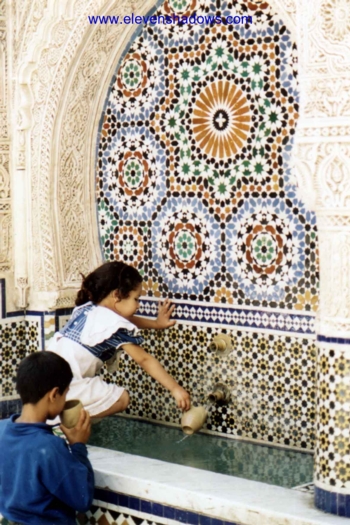 The winding alleys of Fes crammed with bazaars,
restaurants, workshops, mosques seemingly every ten meters, hideous-smelling tanneries
("You get used to it.", said a carpet vendor), fruit and vegetable markets, arts
and crafts, and shoe repair shops. You squeeze past donkeys wearing old tires as
shoes, as cries of "Balek!" ("Look out!") call out from the donkey
drivers. Men or boys barrage you with questions about where you are from or whether
you need a guide -- "Only ten dirhams and I show you around the city." And
it is easy to get lost here in the medina if you veer off the main paths. The winding alleys of Fes crammed with bazaars,
restaurants, workshops, mosques seemingly every ten meters, hideous-smelling tanneries
("You get used to it.", said a carpet vendor), fruit and vegetable markets, arts
and crafts, and shoe repair shops. You squeeze past donkeys wearing old tires as
shoes, as cries of "Balek!" ("Look out!") call out from the donkey
drivers. Men or boys barrage you with questions about where you are from or whether
you need a guide -- "Only ten dirhams and I show you around the city." And
it is easy to get lost here in the medina if you veer off the main paths. |
| Fun in Fez An Australian guy named Basil and I tried to get as 'lost' as we possibly could. We spent twelve hours wandering all over the medina. We came across a cinema, only to come across it again half an hour later. The guys in this cinema area started approaching us asking if we needed help in remarkably good English, sensing we were lost, but we scampered off on yet a third road leading from this area before we were descended upon. However, about ten minutes later, we had managed to wind ourselves around to another alley leading to the cinema! This time, they were upon us in no time. However, before we could say anything, I said in a mock-frantic voice, "Excuse me, excuse me! We're looking for two people! Have you seen a tall Chinese guy and a blonde Australian guy come through here about ten minutes ago?" Looking rather confused, one of the men hesitated, then pointed in the direction we had last gone, and said, "Uh, they went that way..." The faux guides of Fez are quite persistent. Despite my insistence that I didn't need a guide to explore the city -- after all, how could I get lost if there was someone telling me where to go? -- I still had people following me, insisting that I was in need of their services. "I guide you around medina -- only ten dirham!". This was banned by the government unless someone was in possession of an actual certificate. The common opening question would be, "What country are you from?", assuming that they didn't open with, "Hello Hapon!" ("Hello Japan!"). I frequently answered their question with an obscure, distant land, such as Burma or Bhutan. This, believe it or not, would cause great consternation on their part as they tried to figure out where exactly this was, and how to continue greeting us. Another question would be, "What's your name?". I would reply rapidly with obscure, long names: "Srinivas Anandapanda Nuf-Nuf." One poor guy tried so hard to say the name correctly that he followed us for several minutes saying, "Sriniva....un moment....Sriniva -- em, ah...." and finally just stopped, giving up. And what was especially good sport was ducking into a store while they had diverted their attention, causing great consternation on their part. I figure that if you are going to be barraged by incredibly persistent people, you may as well face it with a sense of humor! The city of Fez was a lot of fun, and exploring the medina was one of the highlights of the trip. It's one of the best places to purchase something, as the prices tend to be noticeably lower than Essaouira, Marrakesh, or other cities. Sefrou From Fez, I traveled to the small Berber town of Sefrou for the day. I wandered around the very small medina, and then started to walk up to the waterfall. A Moroccan man asked if he could walk up with me. I said sure, but told him that I already knew the way. He said that he was just being friendly. We spent the better part of the day hanging out, going to the waterfall, visiting his house, and even making a delicious vegetarian tagine together. A tagine is a dish that is made of ceramic stoneware. The food, often meat, vegetables, olives, and oil, is usually slow-cooked with a conical lid on top, allowing the taste to melt together into a delicious meal. After several hours of talking and hanging out and discussing philosophy and traveling, I said that I had to return to Fez, but told him that I had really enjoyed his company. We exchanged addresses, after which he tried to hit me up for money. This was rather disconcerting, as this happened to me several times during the trip. I was confused. Did this person see me as a friend or a walking $ bill? While many Moroccans are incredibly hospitable, there are a few opportunists who blur friendship and commerce into a distasteful whole. |
 I
took a bus to Chefchaouen from Fez. The bus winded its
way up through the very green Rif Mountains, which are reknowned for its natural beauty
and kif (marijuana). Morocco supplies Europe with at least 30% of its weed, and most
of it is grown here. I
took a bus to Chefchaouen from Fez. The bus winded its
way up through the very green Rif Mountains, which are reknowned for its natural beauty
and kif (marijuana). Morocco supplies Europe with at least 30% of its weed, and most
of it is grown here.Chefchaouen is a very laid-back, relaxing town nestled in the heart of the Rif Mountains. It's a very charming, small town, with a peaceful atmosphere as a result of the setting and the fact that many of its visitors and citizenry are completely stoned. The buildings here are incredibly beautiful, with vivid whitewashes and striking blue doors. Many of the doorways and alleys are vividly painted and very rounded, evoking a feeling not unlike some surrealistic penguin exhibit at the zoo! |
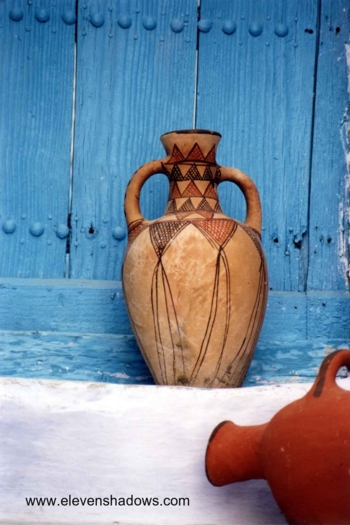 I stayed at the charming Spanish-style Pension
Mauritania in Chefchaouen, which had an attractive lounge area. Seven or eight guys
from Spain would sit down here all day, smoking kif. I would wander down in the
morning, and they would already be sitting there, shirts off, sliding into their seats
with a large smoke cloud hanging over their heads. Reaching up with a fat smokin'
jay, "Quieras?" would be uttered, that eternal gesture of bonding among fellow
kif smokers. I would politely decline (I don't smoke). Returning during
lunch time, I would find them still there, in the same seats, same positions, with an even
larger smoke cloud hanging overhead. A guy would come by around 1:30 p.m. every day
with a brown package the size of a very large brick. Dirhams would be exchanged, and
everyone was happy. I stayed at the charming Spanish-style Pension
Mauritania in Chefchaouen, which had an attractive lounge area. Seven or eight guys
from Spain would sit down here all day, smoking kif. I would wander down in the
morning, and they would already be sitting there, shirts off, sliding into their seats
with a large smoke cloud hanging over their heads. Reaching up with a fat smokin'
jay, "Quieras?" would be uttered, that eternal gesture of bonding among fellow
kif smokers. I would politely decline (I don't smoke). Returning during
lunch time, I would find them still there, in the same seats, same positions, with an even
larger smoke cloud hanging overhead. A guy would come by around 1:30 p.m. every day
with a brown package the size of a very large brick. Dirhams would be exchanged, and
everyone was happy.Occasionally, I would come back into the hotel to find that several of them had changed positions. I began joking with several of them -- "Hey, you changed positions! What happened?" They'd laugh, and return to their project of trying to make that smoke cloud even larger. |
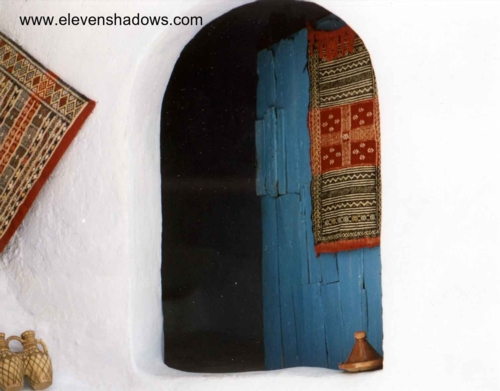 IOne of the many attractive doorways in Chefchaouen. Note the tagine bowl at the lower right hand corner of the doorway. IOne of the many attractive doorways in Chefchaouen. Note the tagine bowl at the lower right hand corner of the doorway.
Chefchaouen was a really good place to do nothing. We ate, relaxed, talked, swam in the swimming pool of Hotel Parador, and then ate some more. Plaza Uta el-Hammam has attractive cafes that made relaxing all the more pleasant. |
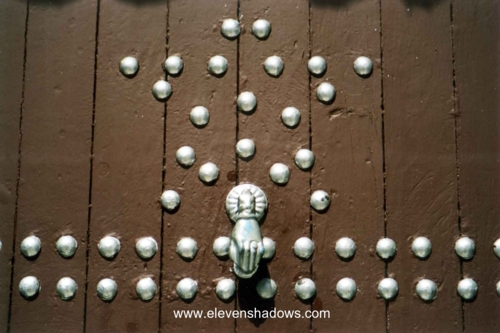 Doorway in one of the side alleys of
Chefchaouen. As with many towns in Morocco, Chefchaouen had a fairly substantial
Jewish community, and the influence of this still remains. Doorway in one of the side alleys of
Chefchaouen. As with many towns in Morocco, Chefchaouen had a fairly substantial
Jewish community, and the influence of this still remains. Chefchaouen was built in the 15th century as a base from which to attttack the Portuguese in Ceuta, and thrived considerably upon the arrival of Muslim refugees from Spain. These refugees built the whitewashed houses and blue-painted doors (okay, this one isn't blue!) and gave the whole town its distinctly Hispanic feel. |
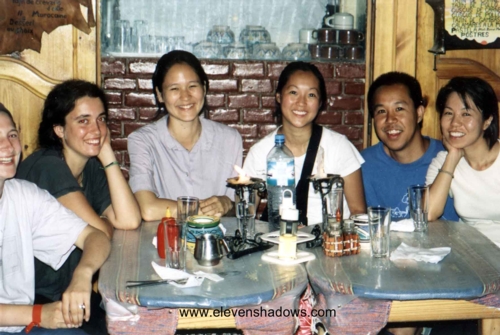 I met Keiko, a solo Japanese traveler (far right) in
Chefchaouen, and we decided to travel to Spain together. Here we are spending our
last evening in Chefchaouen at Aladdin's Restaurant, with half of Claire and Hannah (from
London -- I met them earlier in Fez), and Erin (Atlanta, Georgia) and Loretta (Ontario,
Canada), whom I met in Meknes. My favorite travelers all at the same table! I met Keiko, a solo Japanese traveler (far right) in
Chefchaouen, and we decided to travel to Spain together. Here we are spending our
last evening in Chefchaouen at Aladdin's Restaurant, with half of Claire and Hannah (from
London -- I met them earlier in Fez), and Erin (Atlanta, Georgia) and Loretta (Ontario,
Canada), whom I met in Meknes. My favorite travelers all at the same table! |
| Going North to Spain We took a bus up to Ceuta, a town that is in Spanish-owned Morocco, set our watches two hours ahead when we crossed the border, took a speedy 40-minute ferry across to Algeciras, Spain, and then took a two-hour train ride northward to the lovely town of Ronda, in the southern Andalucían region of Spain which is famous for its pueblos blancos, or white towns, which are perched up along the mountainsides. |
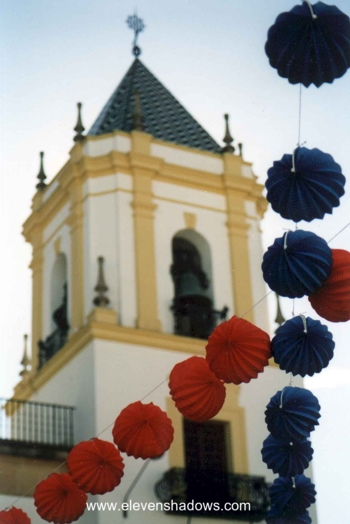 Ronda,
Spain. This picture
was taken in the Plaza de Socorro during one of the August music festivals. Ronda,
Spain. This picture
was taken in the Plaza de Socorro during one of the August music festivals.Ronda is a storybook village come to life for me. It is perched up on a cliff, which plummets down several hundred meters, with much of the town just about hanging off the sides very dramatically. Rio Guadelevin cuts a gaping chasm in the center, dividing the town in half, connected primarily by the Puente Nuevo (New Bridge). I have a picture of this bridge and the bluffs in an upcoming page.
|
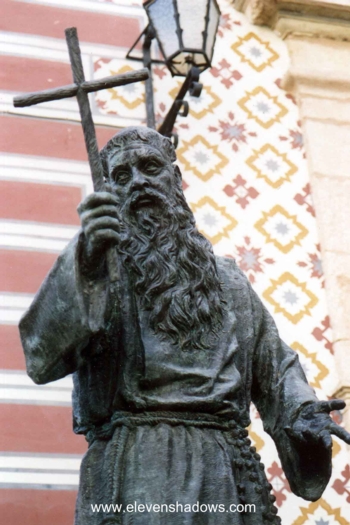 There were quite a few charming cafes and
delicious restaurants, and we gorged ourselves on paella, wine, sangria, and flan. There were quite a few charming cafes and
delicious restaurants, and we gorged ourselves on paella, wine, sangria, and flan.
This photo is taken in front of Casa del Gigante, a former Muslim palace built in the 14th century, in Ronda, Spain. |
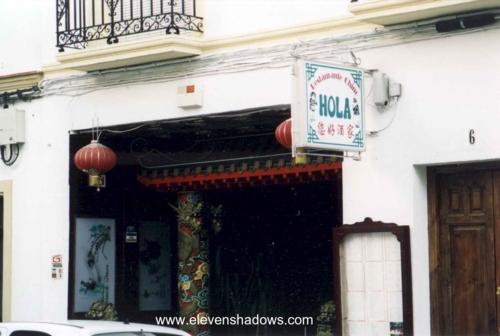 A Chinese restaurant in Ronda, Spain, named
"Hola". The Chinese manager greeted us with very good Spanish, and we ate
some very delicious soup here. A Chinese restaurant in Ronda, Spain, named
"Hola". The Chinese manager greeted us with very good Spanish, and we ate
some very delicious soup here. |
| From Ronda, Keiko and I took a bus to the beachtown resort of Cádiz on the Costa de la
Luz on the Atlantic Coast. As it was peak tourist season, we didn't stand much of a
chance of getting much of a hotel. The fact that it was a weekend and there was a
bullfight in town didn't seem to help any, either! We ended up taking a bus from
Cádiz to Granada on an overnight bus, using the time-honored traveller method of the bus
as a hotel. We slept, or rather, attempted to sleep, the remainder of the time in
the Granada bus station, an exercise in futility since the guards insisted that we sleep
in a sitting position. We got a hostel very close to the cathedral run by an absolutely loony lady by the name of Pepita. I could understand her Spanish very well because she had the habit of repeating everything constantly. She even asked me to answer the phones for her while she ran around attending to everything -- she was the only one who worked at the hostel. |
 |
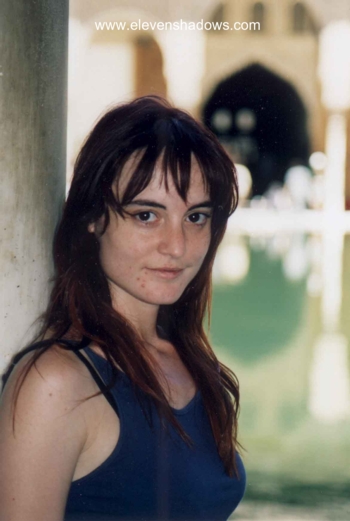 |
|
Keiko wisely chose to go to sleep, while I decided to walk up to the lovely Andalucían
palace of Alhambra, shown above, even though I had only gotten about three hours of sleep.
As you can probably notice, much of Alhambra was built by the Muslims. While waiting in line for tickets in Alhambra, I met three charming ladies from Barcelona (yes, I know, there are only two there -- the third one liked being on the other side of the camera, as she was an amateur photographer). They offered to show me around Alhambra, as this was their third day in a row that they had visited Alhambra. To the left is Athea, and to the right is Estaire. We spent the entire day roaming all throughout Alhambra and hanging out at the Kasbah Cafe afterwards -- a very pleasant day. The three only spoke Spanish, but with my broken Spanish and a little persistence, we managed to communicate quite well. |
Morocco and Spain 1999
Page 2
Morocco and Spain Home Page
Eleven Shadows Travel Page
Contact photographer/musician Ken Lee